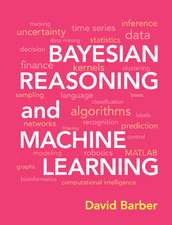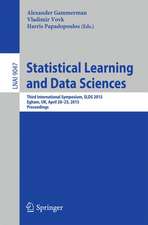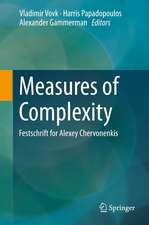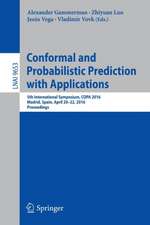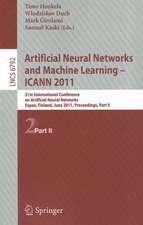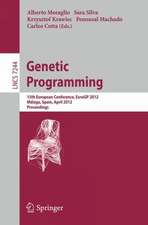Algorithmic Learning in a Random World
Autor Vladimir Vovk, Alex Gammerman, Glenn Shaferen Limba Engleză Hardback – 22 mar 2005
Preț: 1167.83 lei
Preț vechi: 1459.78 lei
-20% Nou
Puncte Express: 1752
Preț estimativ în valută:
223.45€ • 233.33$ • 184.53£
223.45€ • 233.33$ • 184.53£
Carte tipărită la comandă
Livrare economică 15-29 aprilie
Preluare comenzi: 021 569.72.76
Specificații
ISBN-13: 9780387001524
ISBN-10: 0387001522
Pagini: 324
Ilustrații: XVI, 324 p. 62 illus.
Dimensiuni: 155 x 235 x 24 mm
Greutate: 0.69 kg
Ediția:2005
Editura: Springer Us
Colecția Springer
Locul publicării:New York, NY, United States
ISBN-10: 0387001522
Pagini: 324
Ilustrații: XVI, 324 p. 62 illus.
Dimensiuni: 155 x 235 x 24 mm
Greutate: 0.69 kg
Ediția:2005
Editura: Springer Us
Colecția Springer
Locul publicării:New York, NY, United States
Public țintă
ResearchDescriere
Algorithmic Learning in a Random World describes recent theoretical and experimental developments in building computable approximations to Kolmogorov's algorithmic notion of randomness. Based on these approximations, a new set of machine learning algorithms have been developed that can be used to make predictions and to estimate their confidence and credibility in high-dimensional spaces under the usual assumption that the data are independent and identically distributed (assumption of randomness). Another aim of this unique monograph is to outline some limits of predictions: The approach based on algorithmic theory of randomness allows for the proof of impossibility of prediction in certain situations. The book describes how several important machine learning problems, such as density estimation in high-dimensional spaces, cannot be solved if the only assumption is randomness.
Cuprins
Preface.- List of Principal results.- Introduction.- Conformal prediction.- Classification with conformal predictors.-Modifications of conformal predictors.- Probabilistic prediction I: impossibility results.- Probabilistic prediction II: Venn predictors.- Beyond exchangeability.- On-line compression modeling I: conformal prediction.- On-line compression modeling II: Venn prediction.- Perspectives and contrasts.- Appendix A: Probability theory.- Appendix B: Data sets.- Appendix C: FAQ.- Notation.- References.- Index
Recenzii
From the reviews:
"Algorithmic Learning in a Random World has ten chapters, three appendices, and extensive references. Each chapter ends with a section containing comments, historical discussion, and bibliographical remarks. … The material is developed well and reasonably easy to follow … . the text is very readable. … is doubtless an important reference summarizing a large body of work by the authors and their graduate students. Academics involved with new implementations and empirical studies of machine learning techniques may find it useful too." (James Law, SIGACT News, Vol. 37 (4), 2006)
"Algorithmic Learning in a Random World has ten chapters, three appendices, and extensive references. Each chapter ends with a section containing comments, historical discussion, and bibliographical remarks. … The material is developed well and reasonably easy to follow … . the text is very readable. … is doubtless an important reference summarizing a large body of work by the authors and their graduate students. Academics involved with new implementations and empirical studies of machine learning techniques may find it useful too." (James Law, SIGACT News, Vol. 37 (4), 2006)
Textul de pe ultima copertă
Conformal prediction is a valuable new method of machine learning. Conformal predictors are among the most accurate methods of machine learning, and unlike other state-of-the-art methods, they provide information about their own accuracy and reliability.
This new monograph integrates mathematical theory and revealing experimental work. It demonstrates mathematically the validity of the reliability claimed by conformal predictors when they are applied to independent and identically distributed data, and it confirms experimentally that the accuracy is sufficient for many practical problems. Later chapters generalize these results to models called repetitive structures, which originate in the algorithmic theory of randomness and statistical physics. The approach is flexible enough to incorporate most existing methods of machine learning, including newer methods such as boosting and support vector machines and older methods such as nearest neighbors and the bootstrap.
Topics and Features:
* Describes how conformal predictors yield accurate and reliable predictions, complemented with quantitative measures of their accuracy and reliability
* Handles both classification and regression problems
* Explains how to apply the new algorithms to real-world data sets
* Demonstrates the infeasibility of some standard prediction tasks
* Explains connections with Kolmogorov’s algorithmic randomness, recent work in machine learning, and older work in statistics
* Develops new methods of probability forecasting and shows how to use them for prediction in causal networks
Researchers in computer science, statistics, and artificial intelligence will find the book an authoritative and rigorous treatment of some of the most promising new developments in machine learning. Practitioners and students in all areas of research that use quantitative prediction or machine learning will learn about important new methods.
This new monograph integrates mathematical theory and revealing experimental work. It demonstrates mathematically the validity of the reliability claimed by conformal predictors when they are applied to independent and identically distributed data, and it confirms experimentally that the accuracy is sufficient for many practical problems. Later chapters generalize these results to models called repetitive structures, which originate in the algorithmic theory of randomness and statistical physics. The approach is flexible enough to incorporate most existing methods of machine learning, including newer methods such as boosting and support vector machines and older methods such as nearest neighbors and the bootstrap.
Topics and Features:
* Describes how conformal predictors yield accurate and reliable predictions, complemented with quantitative measures of their accuracy and reliability
* Handles both classification and regression problems
* Explains how to apply the new algorithms to real-world data sets
* Demonstrates the infeasibility of some standard prediction tasks
* Explains connections with Kolmogorov’s algorithmic randomness, recent work in machine learning, and older work in statistics
* Develops new methods of probability forecasting and shows how to use them for prediction in causal networks
Researchers in computer science, statistics, and artificial intelligence will find the book an authoritative and rigorous treatment of some of the most promising new developments in machine learning. Practitioners and students in all areas of research that use quantitative prediction or machine learning will learn about important new methods.
Caracteristici
About conformal prediction, which is a valuable new method of machine learning
Conformal predictors are among the most accurate methods of machine learning, and unlike other state-of-the-art methods, they provide information about their own accuracy and reliability
Conformal predictors are among the most accurate methods of machine learning, and unlike other state-of-the-art methods, they provide information about their own accuracy and reliability


